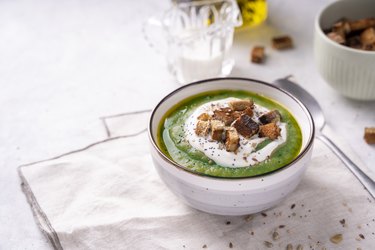
There's nothing like a big bowl of warm, soothing soup on a crisp day to make you feel cozy. But if you're trying to be healthier, you might be canning the canned soups — which often contain preservatives, additives and excessive sodium — for a homemade batch instead.
While soup made from scratch can be a more nutritious option, there's also a lot of ways you can unwittingly sabotage your stock (and good intentions). Here, Erika Fox, RDN, dietitian and community manager for 310 Nutrition, discusses five common mistakes you might be making with homemade soups, plus offers tips for nailing how to make a healthy soup.
Video of the Day
Video of the Day
1. You Add Too Much Salt
"Canned soups are known for commonly containing large amounts of sodium, but what many people don't realize is that even when you're making soup at home, it's easy to go overboard on salt," Fox says.
Think about how many times you shake a little here or toss a dash there during the cooking process. And that doesn't even count the pinch you toss in once it's on the table. But these little salt sprinkles can really add up.
"The current daily recommendation for sodium is no more than 2,300 milligrams, which, to put into perspective, is about 1 teaspoon," Fox says. One of the problems with consuming too much sodium is that it can increase your blood pressure, which, in turn, can raise your risk for heart disease and stroke, according to the Centers for Disease Control and Prevention.
Fix It: Alternatively, Fox recommends omitting salt during the cooking process — which will slash the sodium content of your soup — and incorporating flavorful spices instead. And if you still crave a little salt in your soup bowl, you can add a speck to taste at the table.
2. You Use a High-Sodium Broth or Bouillon
Even if you've sacked the salt during the cooking process, your soup might still be (unintentionally) stuffed with sodium. "Many canned and packaged foods contain large amounts of sodium, especially broth," Fox says. And it's the same issue with bouillon cubes and powders, which often pack lots of salt and MSG (monosodium glutamate), which is sodium used to enhance flavor.
Luckily, there's a simple solution: "You can easily reduce the amount of sodium in your homemade soups by switching to a low-sodium broth," Fox says.
The term "low-sodium" is defined as having 140 milligrams or less per serving. However, if a food is labeled "reduced-sodium," this doesn't necessarily equate to low-sodium. That's because "reduced sodium" means that a food's sodium content has been reduced by 25 percent compared to the original product, Fox explains. For example, if a brand's chicken broth usually contains 650 milligrams of sodium, their reduced-sodium product might have 487 milligrams of sodium.
Fix It: All this to say, when buying a broth or bouillon, always check the nutrition label and aim for around 140 milligrams of sodium (or less) per serving.
And don't fret about losing any flavor with low-sodium varieties: "You won't even notice the difference in taste, but you're making such a big difference in terms of health," Fox says.
3. You Start With a Cream Base
Sure, creamy soups are scrumptious, but they can also be calorie bombs. When cream is the base of your soup, it can add large amounts of fat, and therefore calories, to your meal, Fox says.
What's more, dairy products like cream can be inflammatory, causing stomach discomfort for some people, she adds.
Fix It: To avoid this, Fox recommends opting for broth-based soups whenever possible. When you're making cream-based soups, consider ditching the dairy for plant-based alternatives. For example, try making cashew cream:
- Soak a quarter cup of cashews in hot water for 10 to 20 minutes
- Drain the water
- Add the soaked cashews to a high-speed blender with an additional half a cup (to one cup) of water
You could also puree cooked vegetables with vegetable stock/broth or a small amount of cashew cream to produce a velvety vegetable soup.
4. You Don’t Incorporate Protein
If your soup is all veggies and broth and no protein, it won't keep you satisfied for long.
"Leaving out protein in your homemade soup can lead to an unbalanced meal," Fox says. "Whether you're making soup or another type of meal, it's important to always aim for a balance of complex carbohydrates, fat and protein to help make sure you're getting the nutrients you need to keep your body functioning properly."
Fix It: Fortunately, there are endless ways to incorporate protein sources into your soup bowl. Lob in legumes like lentils, stir in some shredded lean chicken breast or make a veggie chili with a variety of beans.
And if you prefer slurping to chewing, blend chickpeas, white beans or silken tofu into creamy vegetable soups for a seamless way to add protein, Fox says.
5. You Add Unhealthy Toppings
From crackers to croutons and tortilla strips, there's no shortage of savory soup toppers. While tossing toppings into soup isn't necessarily a bad thing, it's definitely good to be cautious about how much you're adding, Fox says.
Again, depending on your selections, a handful here or there can result in hundreds of extra calories (and grams of fat), which can hinder health goals like weight loss.
Fix It: If you enjoy toppings, Fox recommends measuring them out beforehand to keep serving sizes in a healthy range and opting for whole-food add-ons instead of processed foods. Some of Fox's favorites are:
- fresh herbs
- nuts
- seeds
- roasted chickpeas
Was this article helpful?
150 Characters Max
0/150
Thank you for sharing!
Thank you for your feedback!